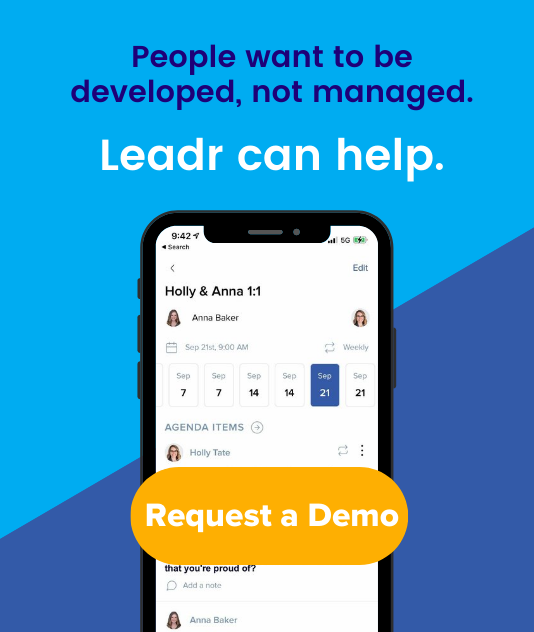5 Building Blocks For A Strong Feedback Culture
No matter where you’ve worked in the past, you’ve likely had a range of experiences when it’s come to feedback in your role. Maybe your boss was great at giving feedback but lacked the time to invest in helping you achieve the goals they set for you. Or maybe you only have gotten feedback during your annual performance review, leading to anxiety and a lack of clarity on expectations and goals throughout the year. The presence or lack of great feedback from your supervisor can transform your experience in a workplace.
If you’re a leader, maybe you’ve been unsure how to deliver effective feedback, or maybe you manage a large team and struggle with prioritizing time to meet one on one with team members. In either case, it’s important that you thoughtfully reflect on how and when you give feedback This will give you valuable insight into how feedback has translated to your team’s longevity, productivity, or contentment in their role.
Here are five considerations to help you get started on cracking the code on a culture of healthy feedback.
1. What does a healthy culture of feedback actually look like?
The best place to start is setting clear shared values and expectations. Knowing exactly what your team envisions as a healthy culture of feedback actually looks like is a foundational starting point to getting on the same page and being able to work cohesively as a team.
Everyone is bringing a different experience with feedback to the table. If someone goes from a corporate role to a ministry role, it’s likely that they’ll experience a significant shift in workplace culture because of the nature of two different industries and the way they do things. It may require an adjustment on your team, to navigate that when you join or when you onboard a new team member. Make that a day one step, or consider including something about it in your onboarding materials.
Take the time to sit down and have a clear and open conversation about what feedback looks like. It's a great starting place for a new team member to begin their time at an organization knowing where they are going, both in terms of their role and in the context of their wellbeing at the company itself. That begins with feedback and setting clear expectations.
2. Everyone gives feedback, regardless of position.
Another important expectation to set is the importance of feedback being given and received all the way across your organizational chart. This is not just limited to managers coaching their direct reports. It’s also important for team members to see that executive leaders all the way to the top are also actively sharing and hearing feedback too.
Make it a habit to ask for feedback in person and in writing. And then act on it regularly! A great way to do this is to request feedback in every staff meeting and then follow up with an email so team members can share thoughts, ideas or concerns. As your team warms up to this exercise, you can ask three essential questions to garner great feedback from your team, whether that’s one on one or in a group meeting:
-
What should I start doing to lead better?
-
What should I stop doing to lead you better?
-
What do we need to keep doing?
These questions allow you to be more than just an “approachable” or “open door” leader. It shows your team that not only do you care about them, but you also take ideas or concerns seriously, which go a long way in building trust and psychological safety.
This might also shed some light on where the next steps for development opportunities are if you notice that a team member is asking for more responsibility, or more coaching in a specific area.
3. The way you give feedback matters.
Don’t forget that in addition to regularity and consistency, feedback should also be equal parts positive and constructive. Feedback should be meant mainly to develop a team member, not tear them down or punish them. When feedback is episodic - such as only occurring after a mistake is made or a process has broken down, or even in the heat of the moment - the rhythm of trust and development is disrupted.
When giving or receiving feedback, strive to have every team member embrace what Les McKeown calls, “the enterprise commitment.” When working in a team or a group environment, each person places the interests of the enterprise above their personal interests. This is key, because when listening or hearing feedback from someone else, it’s tempting to become territorial and defensive. But when each person prioritizes the organization above personal interests, it’s a lot easier to receive feedback objectively and to take it as a stepping stone towards growth. When your team operates from the mindset of “we are all here to serve this greater mission so I've got to put that above my personal interest,” they adopt a posture that is receptive to feedback. It’s not personal. But when taken seriously, it can help that person grow.
Remember, this mindset first needs to be adopted by the leader. Before delivering feedback, think about how your input will benefit the organization vs. your personal interests and preferences.
4. There’s a difference between coaching and criticism.
How do you know if feedback is healthy feedback? Ask yourself if it’s coaching or criticism. To be a healthy organization, it's really important that you understand the difference between these two. Criticism is the expression of disapproval of someone or something based on perceived faults or mistakes. Coaching is focused on developing someone, where an experienced person supports a learner or client in achieving a specific, personal or professional goal by providing training and guidance.
As a leader, when giving feedback, consider leading with an attitude of a coach instead. It’s much easier for someone to receive the feedback you’re giving because they can hear it from a form of development rather than disapproval of their faults or mistakes.
Three quick questions to mentally ask yourself if you’re wondering if an interaction is more coaching oriented or serving criticism:
-
Is this “in the moment” or “in the meeting” feedback?
-
Is this a public or private convo?
-
Is this convo going to change anything?
These questions can help you quickly diffuse a conflict fueled instance of feedback, and it can also help you give more specific, actionable feedback that is helpful and valuable and not just colored by emotions or circumstances. This is also helpful when you may need to give feedback to a team member who doesn’t receive feedback well. That can be a difficult leadership situation to navigate, but as our leadership coach and CEO of The 4Sight Group, Jenni Catron, says, “I’m not here to make them happy. I’m here to make them better in their role and help them grow.”
5. Good feedback depends on appropriate context.
As a leader, you may wear many hats - sometimes you may be more of a peer, and sometimes you may need to operate in a true manager role. As you give feedback, ask yourself, which hat am I wearing? Will the feedback I want to give benefit the goal we’re working on right now? Healthy feedback depends on it being given in an appropriate context.
Coach your team members to clarify which hat you’re wearing if they aren’t sure, so they can be best prepared to hear what you’re saying in a context that allows them to fully understand and process it. This is especially important for ministry teams where boss and pastor roles may overlap. With clear communication, you can avoid misunderstandings or resentment and move forward with the goals your feedback needs to accomplish.
Paul Santagata, Head of Industry at Google says “there is no team without trust.” Be proactive about letting your team know when you're wearing what hat. This will go a long way in building and fostering a sense of psychological safety, where your team believes they won’t be punished when they make a mistake. This allows them to take risks and have breakthroughs and fresh insight on their role. They can speak their mind and be creative! This is something you should reflect on daily as a leader. Is this an environment where mistakes are an opportunity to learn?
In practice, a workplace atmosphere of psychological safety means - according to author Shane Snow, - “assuming good intent is foundational in fostering this environment.” Your team must know that you trust them and that you have their best interests in mind in order to feel safe in taking risks and sharing new ideas that may not work.
Creating Your Culture Of Feedback
The ability to give effective feedback is a critical skill for every manager, and it goes hand in hand with workplace and team culture. If you aren’t sure where to start, the great news is that learning to give great feedback is a process you can start as soon as your next one on one meeting.
It’s a continuous practice to learn, sometimes fail at, and reflect on, but it’s a crucial piece to unlocking a culture that celebrates individual strengths, helps employees grow and develop, and empowering your team to lead, and take risks to do better work for your customers.
At Leadr, we believe so much in the power of effective feedback that we’ve made it the heartbeat of our people development software. Frequent feedback is one of our 5 foundations and we’re passionate about helping teams like yours create healthy cultures that develop your team members. Our platform will help you start having consistent, productive and valuable one-on-one meetings with your team that allow you to maximize each team member’s strengths for personal and organizational development. Want to see Leadr in action? Request a demo with someone on our team.
As a practical first step to building your culture of feedback, reflect and share with us: Has feedback in your role or as a manager been difficult or not? Where do you struggle? We can’t wait to hear how these considerations help you.
This blog was adapted from a Leadr webinar with Jenni Catron at the Foresight Group. Check out the full webinar on-demand here.
Share this
You May Also Like
These Related Stories

4 Game-Changing Outcomes Of A Healthy Feedback Culture

Not a Dirty Word: Taking Back The Meaning of “Feedback”







No Comments Yet
Let us know what you think